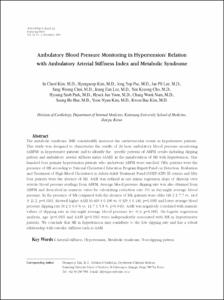Ambulatory Blood Pressure Monitoring in Hypertension: Relation with Ambulatory Arterial Stiffness Index and Metabolic Syndrome
- Keimyung Author(s)
- Kim, In Cheol; Kim, Hyung Seop; Cho, Yun Kyeong; Park, Hyoung Seob; Yoon, Hyuck Jun; Nam, Chang Wook; Hur, Seung Ho; Kim, Yoon Nyun; Kim, Kwon Bae
- Department
- Dept. of Internal Medicine (내과학)
- Journal Title
- Keimyung Medical Journal
- Issued Date
- 2013
- Volume
- 32
- Issue
- 2
- Abstract
- The metabolic syndrome (MS) considerably increases the cardiovascular events in hypertensive patients. This study was designed to characterize the results of 24 hour ambulatory blood pressure monitoring (ABPM) in hypertensive patients and to identify the specific patterns of ABPM results including dipping pattern and ambulatory arterial stiffness index (AASI) in the manifestation of MS with hypertension. One hundred four primary hypertension patients who underwent ABPM were enrolled. Fifty patients were the presence of MS according to National Cholesterol Education Program Expert Panel on Detection, Evaluation and Treatment of High Blood Cholesterol in Adults-Adult Treatment Panel (NCEP-ATP) III criteria and fifty four patients were the absence of MS. AASI was defined as one minus regression slope of diastolic over systolic blood pressure readings from ABPM. Average blood pressure dipping rate was also obtained from ABPM and described in numeric value by calculating reduction rate (%) in daynight average blood pressure. In the presence of MS compared with the absence of MS, patients were older (49.2 ± 7.7 vs. 44.6 ± 11.2, p=0.016), showed higher AASI (0.400 ± 0.196 vs. 0.329 ± 0.146, p=0.038) and lower average blood pressure dipping rate (9.2 ± 6.6 % vs. 11.7 ± 5.8 %, p=0.043). AASI was negatively correlated with numeric values of dipping rate in daynight average blood pressure (r= -0.3; p=0.015). On logistic regression analysis, age (p=0.015) and AASI (p=0.036) were independently associated with MS in hypertensive patients. We conclude that MS in hypertension may contribute to the low dipping rate and has a robust relationship with vascular stiffness such as AASI.
- Alternative Title
- Ambulatory Blood Pressure Monitoring in Hypertension: Relation
with Ambulatory Arterial Stiffness Index and Metabolic Syndrome
- Publisher
- Keimyung University School of Medicine
- Citation
- In Cheol Kim et al. (2013). Ambulatory Blood Pressure Monitoring in Hypertension: Relation with Ambulatory Arterial Stiffness Index and Metabolic Syndrome. Keimyung Medical Journal, 32(2), 131–138.
- Type
- Article
- Appears in Collections:
- 2. Keimyung Medical Journal (계명의대 학술지) > 2013
1. School of Medicine (의과대학) > Dept. of Internal Medicine (내과학)
- 파일 목록
Items in Repository are protected by copyright, with all rights reserved, unless otherwise indicated.
